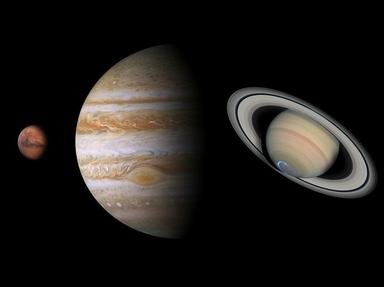Quiz Answer Key and Fun Facts
1. Our Sun is primarily composed of the elements helium and hydrogen. However, there are smaller amounts of other elements. Rounding to the nearest whole number, what percentage of the Sun is oxygen?
2. In the second century AD (or CE), Claudius Ptolemaeus described a geocentric model of the universe where the Sun revolved around the Earth rather than the other way around. In this model, how many bodies orbited closer to the earth than the sun?
3. Sunlight, like other kinds of light, travels at an incredibly fast speed. In fact, sunlight travels from the Sun to the Earth in a little more than eight minutes. Rounding to the nearest whole minute, how many minutes does it take for sunlight to travel to Mercury? (Assume Mercury is its average distance from the sun.)
4. In an Earth year, there are about 365 1/4 days. On Venus, however, the year is much shorter--at least in terms of Venusian days. Rounding to the nearest whole number, how many sidereal Venusian days are there in one Venusian year?
5. Mars, like other planets in the Solar System, has moons. These moons were discovered in 1877. In Jonathan Swift's "Gulliver's Travels," written 150 years earlier, a character refers to a Martian moon or moons. How many moon(s) did this character (accurately) say orbited Mars?
6. Jupiter is the largest of the planets in our Solar System and has a large number of moons. Galileo Galilei was the first to observe a satellite around any planet besides Earth when he used an early telescope in 1609-1610. When we refer to the Galileian Moon or Moons, just how many are there?
7. First it is a planet, then it's not a planet. Pluto's classification has changed over the years. The knowledge we have of this body is constantly changing and growing. In contrast to many other planets, Pluto is not hundreds or thousands of times larger than its largest moon, Charon. Rounding to the nearest whole number, the ratio between Charon's diameter and Pluto's diameter is 1 to what?
8. The term "blue moon" refers to the second full Moon in a month. Therefore, "once in a blue moon" means "not that often." However, rounding to the nearest full year, how many years are there between blue moons on average?
9. When journeying through or even imagining the solar system, galaxy and universe, large distances are involved. One of these large distances is measured by the Astronomical Unit (AU). Rounding to the nearest whole number, how many AUs is the journey from the Sun to the Earth?
10. Sometimes enormous units of length are needed to describe distances in the universe. One of these is the light year, the distance that light travels in one Earth year. Rounding to the nearest whole number, how many light years are equivalent to 24 trillion miles or 40 trillion kilometers?
Source: Author
bernie73
This quiz was reviewed by FunTrivia editor
CellarDoor before going online.
Any errors found in FunTrivia content are routinely corrected through our feedback system.

